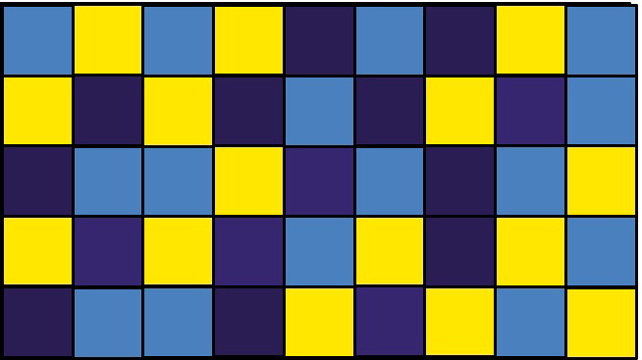Think back to high school chemistry. Your teacher shows you a molecule and starts explaining its many parts. To the teacher, the molecule is simple and understandable. But to you, a sophomore seeing this molecule for the first time, it’s overwhelming.
Helping the 15-year-old you grasp that molecule more quickly is the work of psychology professor Steven Franconeri and his Visual Thinking Lab.
“What’s different about your teacher’s visual system? Did they mentally slice the molecule into different parts? Do they look for redundancies in color?” Franconeri says. “We think about what the teacher’s visual system is doing right, and secondly, how we could teach that to a sophomore.”
Because of the many different real-world applications, deciphering the limits of the visual system is inherently interdisciplinary. Just replace the molecule with an algebraic equation, a bar graph, a chart, or any other data visualization.

The Visual Thinking Lab brings together journalists, engineers and data visualization researchers to think about how visual systems can be used most efficiently, and how people become experts in a given topic.
“A lot of expertise is a little pile of dirty tricks,” Franconeri says. “And if we can figure out how those experts conceptualize visual information, how do we then take that expertise and teach it to a novice really quickly?”
One of the lab’s projects investigated whether people understand new visual representations of trends. Franconeri and post-doctoral researcher Steve Haroz showed people a conventional pair of line charts, with one line showing the number of troops and one line showing the U.S. Army’s budget over time (below, left). People could very clearly see from the two lines that the army budget went up over time, while the number of troops declined overall. But when the same data were charted as one line, people were confused, yet intrigued (below, right).

“People looked at the latter visualization first,” Franconeri says. “They wanted to unpack this new puzzle. It was more engaging than the conventional format.”
The goal of this work is simple, Haroz says: Make an art a bit more of a science.
“With data visualization in general, there’s a lot of advice out there, and kind of like nutritional advice, very little of it is based on evidence,” he says. “When people are using graphs to show information, they’re making a whole series of decisions along the way. We want to provide evidence-based guidelines, based on an understanding of how the human visual system works, showing how each of those decisions will impact a viewer.”
As journalists, government agencies, and others look to communicate information and tell stories in visually engaging ways, making sure their audiences can understand and interpret the data is crucial. With this in mind, Northwestern is launching two new courses: “Presenting Ideas and Data,” taught by Franconeri, and “Evaluating Evidence.”
“When our students graduate and become lawyers, doctors, consultants, journalists or anything else, they’re developing expertise in something,” says Franconeri. “They’re doing analyses and research and then they need to communicate that to other people. Presenting Ideas and Data is a collection of advice on how to communicate.”
Evaluating Evidence, to be offered in fall 2017 and taught by psychology professor Onnie Rogers and linguistics professor Klinton Bicknell, will ask students to deploy qualitative and quantitative methods to better understand the facts surrounding current hot-button issues, like climate change, vaccine safety, and GMO use.
“I expect a lot of graduate students will want to take this course to get a broader sense of what methods are out there that aren’t always taught in their own departments,” Franconeri says.
Franconeri hopes that by better understanding what the visual system does well, and what it doesn’t, his lab will have groundbreaking real-world impact.
“Design and experimentation only get you so far,” he says. “When you’re trying to improve displays, or get a first grader to understand bar graphs, or help that chemistry student comprehend that molecule, you can only get so far before you need to understand how people process information. I hope we can inspire interventions that will actually make displays better for those people who are trying to cure diseases. Or make educational software for the student trying to learn organic chemistry, or help that six-year-old understand a bar graph.”


